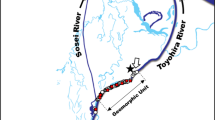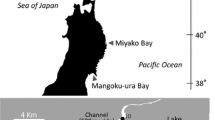Abstract
Egg survival and development rate of perch eggs were investigated in Lake Zürich, Switzerland. A transplant experiment was carried out to examine whether individual females choose different depths for spawning because of an expected advantage for the development of their eggs. Egg masses which had been deposited on fir branches stuck into the ground of the lake were either left untouched or transplanted horizontally or vertically at depths of 3 and 6 m. Spawning occurred between 28 April and 9 June 1987. Egg survival to the eye pigment stage (EPS) was high in all treatments (\(\bar x = 99\% \), minimum 92%). There was no significant difference in egg survival between treatments, suggesting that females do not choose the spawning site because of individual fitness differences related to the depth of spawning. Early egg masses which were exposed to lower temperatures developed more slowly (120–140 day degrees to the EPS) than late egg masses which were exposed to higher temperatures (80–100 day degrees). The observed differences are in agreement with the hypothesis of a constant sum of day degrees necessary for egg development using the corrected formula derived by Guma'a (1978) which deducts an estimated threshold temperature of 5°C below which development of perch eggs effectively stops, from the actual temperature.
Similar content being viewed by others
References
Ayre, D. J., 1985. Localized adaptation of clones of the sea anemoneActinia tenebrosa. Evolution 39: 1250–1260.
Guma'a, S. A., 1978. The effects of temperature on the development and mortality of eggs of perchPerca fluviatilis. Freshwater Biol. 8: 221–227.
Kokurewicz, B., 1969. The influence of temperature on the embryonic development of the perches:Perca fluviatilis L. andLucioperca lucioperca L. Zool. Poloniae 19: 47–63.
Lang, C., 1981. Densité, localisation, taille et développement des chaînes d'œufs de perchePerca fluviatilis L. dans le Léman de 1979 à 1981. Bull. Soc. Vaud. Sc. Nat. No. 360, 75: 257–265.
Luczynski, M., and J. Dettlaff, 1985. Precocious hatching in Coregoninae embryos by electric stimulation. J. appl. Ichthyol. 1: 157–164.
Newsome, G. E., and J. Tompkins, 1985. Yellow perch egg masses deter predators. Can. J. Zool. 63: 2882–2884.
Swift, D. R., 1965. Effect of temperature on mortality and rate of development of the eggs of the pikeEsox lucius L. and the perchPerca fluviatilis L. Nature 206: 528.
Thorphe, J., 1977. Synopsis of biological data on the perchPerca fluviatilis L. andPerca flavescens Mitch. FAO Fisheries Synopsis 113, Rome.
Treasurer, J. W., 1981. Some aspects of the reproductive biology of perchPerca fluviatilis L. Fecundity, maturation and spawning behaviour. J. Fish. Biol. 18: 729–740.
Author information
Authors and Affiliations
Rights and permissions
About this article
Cite this article
Zeh, M., Ritter, E. & Ribi, G. Spawning and egg development ofPerca fluviatilis in Lake Zürich. Aquatic Science 51, 100–107 (1989). https://doi.org/10.1007/BF00879297
Received:
Accepted:
Issue Date:
DOI: https://doi.org/10.1007/BF00879297




